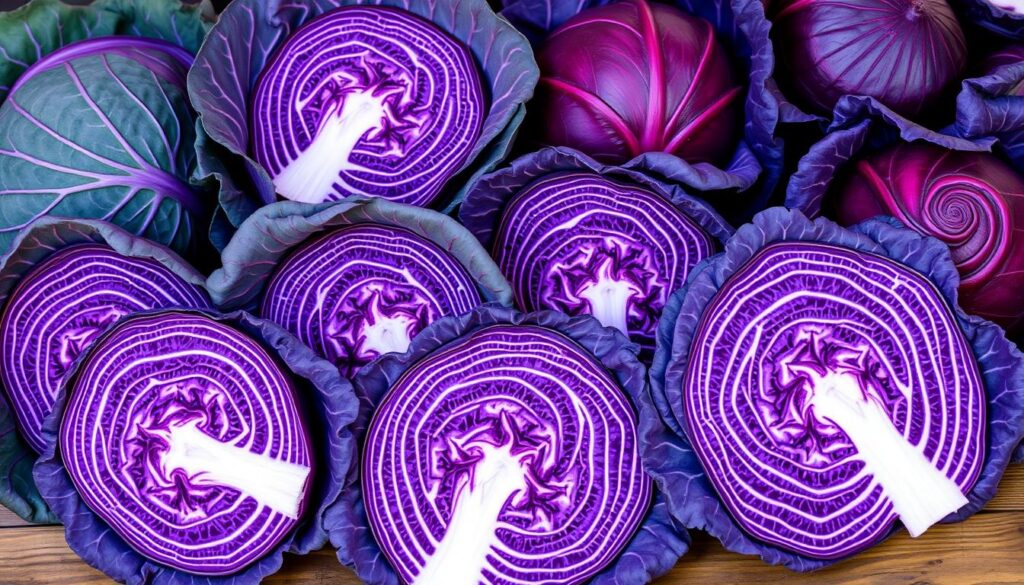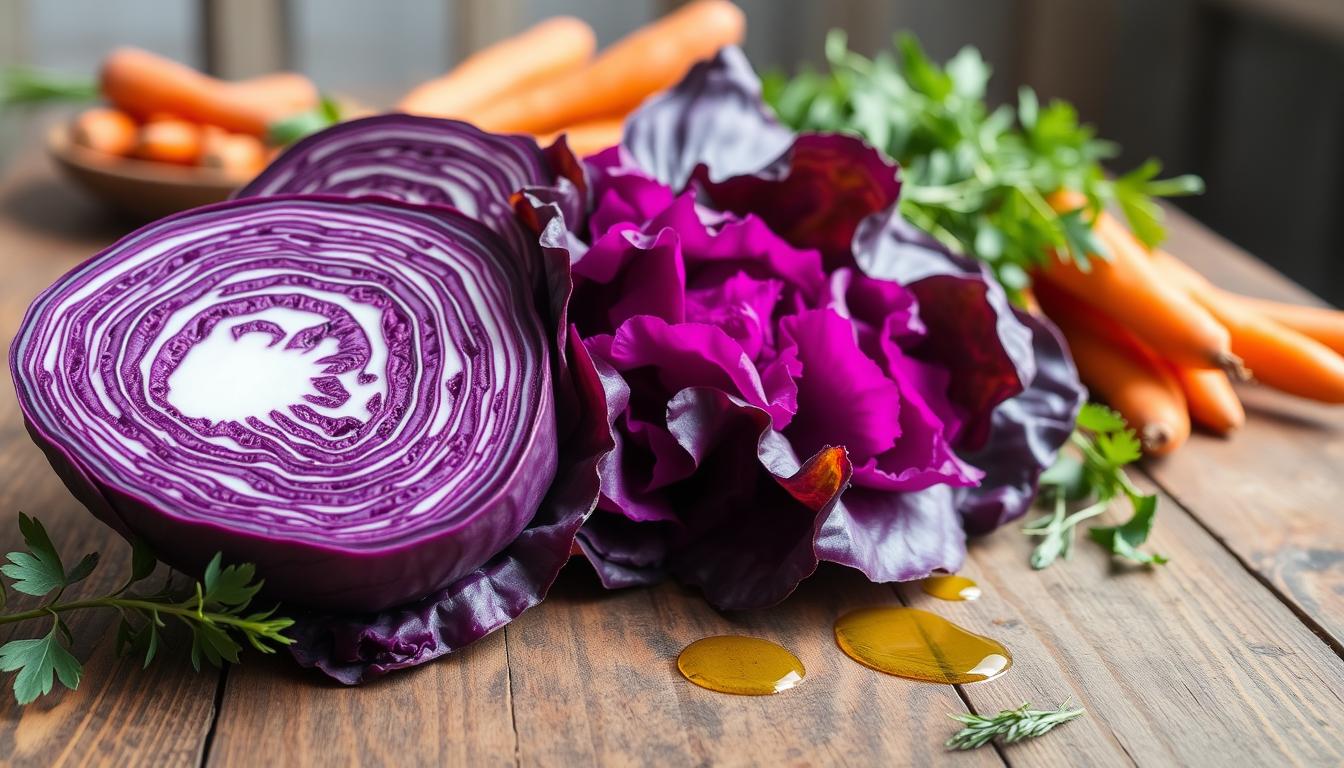Red cabbage is a versatile and nutritious vegetable. It can be enjoyed in many ways. You can have it raw in a salad, cooked in a stew, or pickled for a tangy side dish.
This article will explore the best methods for preparing and eating red cabbage. We’ll look at its impressive nutritional profile and provide tasty recipe ideas. These ideas will showcase its unique taste and texture.
Key Takeaways
- Red cabbage is a nutrient-dense vegetable packed with vitamins, minerals, and antioxidants.
- There are several varieties of red cabbage, each with its own subtle flavor and texture.
- Proper selection and storage of fresh red cabbage is key to ensuring optimal quality and flavor.
- Versatile cooking methods, from roasting to pickling, can bring out the best in red cabbage.
- Pairing red cabbage with complementary ingredients can enhance its taste and nutritional benefits.
Introduction to Red Cabbage
Red cabbage is a vibrant and nutritious member of the cruciferous vegetable family. It’s known for its deep purple-red color and many health benefits. It boosts the immune system and aids digestion, packed with vitamins, minerals, and antioxidants.
Nutritional Benefits of Red Cabbage
One cup of red cabbage gives you over 50% of your daily vitamin C. It also has lots of vitamin K, vitamin B6, and manganese. Plus, it’s full of antioxidants like anthocyanins, which fight inflammation. Eating red cabbage regularly can lower cancer, heart disease, and diabetes risks.
Varieties of Red Cabbage
- Kalibos – A unique conical-shaped red cabbage with a sweet, mild flavor.
- Ruby Ball – A round, deep purple-red cabbage with a crisp texture and slightly peppery taste.
- Mammoth Red Rock – A large, dense red cabbage variety with a bold, earthy flavor.
These are just a few of the many red cabbage varieties out there. Each has its own unique taste and uses in cooking. Trying different types can make your dishes more interesting.

“Red cabbage is a versatile and nutritious vegetable that deserves a place in every home cook’s repertoire.”
Selecting and Storing Fresh Red Cabbage
When picking red cabbage, look for heavy, firm heads with a deep, vibrant color. Stay away from any cabbage that’s damaged or wilted. These signs mean it’s not fresh. The cabbage should feel crisp and look healthy.
After finding the perfect red cabbage, it’s important to store it right. Here are some tips for storing red cabbage:
- Wrap the whole head tightly in plastic wrap or a resealable bag. This keeps moisture in and prevents drying out.
- Put the wrapped cabbage in the fridge. It can last up to 2 weeks there. The cool, controlled environment keeps it fresh and flavorful.
- If you only need part of the cabbage, cut off what you need. Then, rewrap the rest tightly before putting it back in the fridge. This keeps the unused part fresh.
By following these red cabbage storage tips, your cabbage will stay crisp, colorful, and ready for delicious dishes.

“The secret to perfectly stored red cabbage is to keep it tightly wrapped and chilled. This preserves its vibrant color and crunchy texture.”
Preparing Red Cabbage for Cooking
Getting red cabbage ready for cooking is easy but key for its best taste and texture. You might shred, slice, or dice it. The right prep methods can elevate your dish. Let’s look at the best ways to prepare red cabbage and bring out its best.
Cutting Techniques for Red Cabbage
The method you use to cut red cabbage affects your dish’s outcome. Here are some common cutting methods:
- Shredding: For a classic coleslaw or sauerkraut, shred the cabbage. Use a sharp knife or mandoline to get thin, even strips.
- Slicing: For dishes like roasted or sautéed cabbage, slice it thinly. A sharp knife or food processor with a slicing blade works well.
- Dicing: Dice the cabbage for soups, stews, or salads. Cut it into small cubes with a sharp knife.
Choose your cutting method wisely. Always wash the red cabbage thoroughly and remove tough leaves or core before cooking.
“The key to perfectly prepared red cabbage is to slice it evenly and consistently, ensuring each bite is packed with flavor and texture.”
Cooking Methods for Delicious Red Cabbage
Red cabbage is a versatile vegetable that can be enjoyed in many ways. You can have it crisp or tender, depending on how you cook it. There are several methods to explore when preparing this nutritious ingredient.
Sautéing for Crispness
Sautéing red cabbage in a skillet is a popular choice. It keeps the color bright and the texture crunchy. It’s great for stir-fries, slaws, and side dishes. Make sure to slice it thinly for even cooking.
Braising for Tenderness
Braising red cabbage makes it tender and flavorful. Use broth, wine, or vinegar as the cooking liquid. This slow-cooking method makes the cabbage soft and sweet. Cook it covered in the oven or on the stovetop for the best results.
Roasting for Caramelized Edges
Roasting red cabbage brings out its sweetness and creates crispy edges. Toss the cabbage with oil, salt, and pepper. Roast it at a high temperature until it’s tender and lightly browned.
Pickling for a Tangy Twist
Pickling red cabbage gives it a tangy flavor. Soak shredded cabbage in a vinegar brine. It becomes crunchy and slightly sweet. Enjoy it as a condiment or in salads and sandwiches.
Choosing the right cooking method is key to enjoying red cabbage. Let its natural flavors shine by experimenting with seasonings and herbs.
What is the best way to eat red cabbage?
Favorite Red Cabbage Recipes
Red cabbage is a versatile vegetable that can be enjoyed in many ways. Raw red cabbage adds crunch to salads. But cooked, it really shows off its flavor and texture.
Try the classic German-style Rotkohl, or braised red cabbage. It’s made by simmering shredded cabbage in a sweet-and-sour sauce. This dish is tender and perfect as a side or on top of sausages or pork chops.
For something new, make a red cabbage slaw with walnuts, cranberries, and a tangy dressing. This salad is great on its own or adds crunch to sandwiches, tacos, or burgers.
- Braised Red Cabbage with Apples and Onions
- Roasted Red Cabbage Wedges with Lemon-Garlic Dressing
- Red Cabbage and Carrot Slaw with Creamy Horseradish Dressing
- Red Cabbage and Apple Salad with Toasted Pecans
Red cabbage can be enjoyed raw, cooked, or in between. Try different recipes to find your favorite way to eat it.
Pairing Red Cabbage with Other Ingredients
Red cabbage is a versatile ingredient with a strong flavor and crunchy texture. It pairs well with many flavors and textures. Exploring how to mix red cabbage with other ingredients opens up a world of tasty dishes.
Complementary Flavors and Textures
There are many options for what goes well with red cabbage. Its earthy, sweet, and peppery taste goes great with:
- Tangy and acidic flavors, like vinegar, citrus, or yogurt, which balance its bold taste.
- Savory and umami-rich ingredients, such as bacon, soy sauce, or Parmesan cheese, which enhance its natural flavors.
- Sweet elements, including honey, apples, or dried fruit, which contrast nicely with its slight bitterness.
- Crunchy textures, like toasted nuts, seeds, or croutons, which match its crisp, refreshing feel.
By adding these ingredients that pair with red cabbage, you can make a dish that looks and tastes amazing. It’s all about finding the right red cabbage flavor pairings.
“The key to unlocking the full potential of red cabbage lies in its ability to harmonize with a wide range of complementary flavors and textures.”
Creative Ways to Use Red Cabbage
Red cabbage is more than just for coleslaw and braised cabbage. It’s a versatile veggie for many creative dishes. You can make vibrant salads or flavorful slaws with it.
Try making a red cabbage and apple slaw for a tasty side dish. The crisp cabbage and sweet apples are a great combo. Add toasted nuts for a crunchy twist.
Want to wow your guests? Make a stunning red cabbage carpaccio. Slice the cabbage thinly and arrange it. Drizzle with tangy vinaigrette and top with herbs, nuts, and cheese.
- Add shredded red cabbage to your favorite ground beef recipes for color and crunch.
- Roast red cabbage wedges with olive oil, garlic, and seasonings for a tasty side.
- Make a creamy red cabbage tzatziki by blending it with yogurt, lemon, and dill.
| Unique Red Cabbage Dish | Description |
|---|---|
| Red Cabbage Tacos | Use red cabbage leaves as a crunchy taco base. Top with seasoned beef, salsa, and sour cream. |
| Red Cabbage Rolls | Stuff blanched cabbage leaves with rice, meat, and veggies. Bake until tender. |
| Red Cabbage Sushi | Wrap sushi with red cabbage strips. Fill with your favorite ingredients for a crunchy twist. |
“Red cabbage is incredibly versatile. It can be turned into many creative dishes, adding color and flavor to your meals.”
Explore the bold color and crisp texture of red cabbage. Use it in slaws, salads, and even main dishes. It’s a great way to expand your cooking skills and please your taste buds.
Tips for Maximizing Flavor and Nutrition
Enjoying red cabbage’s vibrant flavor and nutritional benefits starts with seasoning and garnishing. Learning how to enhance this versatile vegetable can make every bite special.
Seasoning and Garnishing Red Cabbage
Here are some tips to add depth and complexity to your red cabbage dishes:
- Spice it up: Red cabbage loves warm spices like cumin, caraway, and fennel. A sprinkle of these can boost your dish’s flavor.
- Citrus zest: Lemon, lime, or orange zest adds a bright, acidic note. It brightens your red cabbage dish.
- Fresh herbs: Chopped parsley, dill, or tarragon add a refreshing touch. They also add a green flavor to your red cabbage.
- Toasted nuts or seeds: Sprinkle toasted almonds, walnuts, or pepitas for a crunchy texture. They also add a nutty flavor.
Try these seasoning and garnishing tips to make your red cabbage dishes look and taste great. They’re not just visually appealing but also packed with flavor and nutrition.
“The key to unlocking the true potential of red cabbage lies in the art of seasoning and garnishing. With a few simple tricks, you can transform this humble vegetable into a culinary masterpiece.”
Conclusion
Red cabbage is a superfood that’s great for any healthy diet. It’s packed with vitamins and minerals. Knowing how to pick, store, and cook it makes it easy to add to your meals.
Red cabbage is amazing in salads, sautéed, or in stews. It goes well with many flavors and textures. This makes it a great choice for any meal.
By using the tips from this article, you can make the most of red cabbage. Its vibrant color, strong taste, and crunchy texture make any dish better. It’s a key part of a balanced, nutritious diet.
